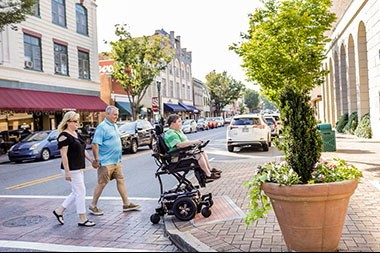Assessing an end user for power mobility can be an intimidating task. Decisions that are made will have an impact on the individual’s quality of life, functional mobility, physical well-being, and social interactions.
This task can seem even more daunting when it comes to the pediatric end user. Children have the natural desire to move, explore, and learn. Research has shown that there is a strong correlation between self-initiated mobility and the development of visual, cognitive, social, language and perceptual skills.
This course will discuss the characteristics and decision-making process for
alternative drive control devices, as well as the special considerations on early power mobility intervention. Potential assessment and training tools for pediatric power mobility will also be explored.
Friday, September 5, 2025
10:00 am – 12:00 pm
WestWorld of Scottsdale, North Hall
Meeting Room 1 (Located outside of the Main Entrance)
16601 North Pima Road
Scottsdale, AZ 85260
Credits: 0.2 AOTA CEUs / 2.0 CEC / 2hr
Level: Intermediate
Registration:
This complimentary course requires registration at Abilities Expo in addition to registration with Quantum Rehab. Space is limited and seats are reserved on a first come, first serve basis.
Prerequisites:
Students should have basic understanding of power wheelchair controls including set up and programming.
Target Audience:
Licensed/Certified Medical Professional (i.e. PT, OT), Rehab Professional (ATP, SMS, CRTS)
Learning Objectives:
At the conclusion of the course the participant will be able to:
- Differentiate the unique considerations that are involved when assessing children for the appropriate drive control device.
- Distinguish 2 reasons why non-proportional drive inputs may be more appropriate than proportional inputs for the pediatric end user.
- Apply 2 different methods for the assessment and training for potential early power mobility interventions.
Agenda:
Hour 1
- Introduction/Key Concepts
- Review Hierarchy of Drive Controls
- Hierarchy of Drive Controls
- Considerations for Pediatric versus Adult End Users
Hour 2
- Considerations for Pediatric versus Adult End Users
- Mobility Training Considerations
- Supplemental Training Possibilities
Instructional Methods:
- Lecture
- Demonstration
- Hands on Programming
- Case Studies
- Brainstorming
AOTA Classification Code:
Occupational Therapy Process: Evaluation and Intervention
ADA:
If you require ADA accommodations, please contact the Education Department ([email protected]).
Course Instructor: Andrea Lewis, OTR/L
Clinical Education Manager, Quantum Rehab
Andrea has been an occupational therapist for 13 years and devoted most of her career to specializing in neurological rehabilitation. In addition, her OT experience has been dedicated to working with a multidisciplinary team helping clients with neurological injuries overcome physical, cognitive, and psychosocial barriers.

She earned a Bachelor of Business Administration degree from The University of Texas at Austin and Master of Occupational Therapy degree from The University of Texas Medical Branch. Educating others is her passion and calling in life and she is endlessly motivated to advocate for the disabled population as well as to help promote one’s full rehab potential as they strive to return to meaningful occupations in all facets of their lives.



